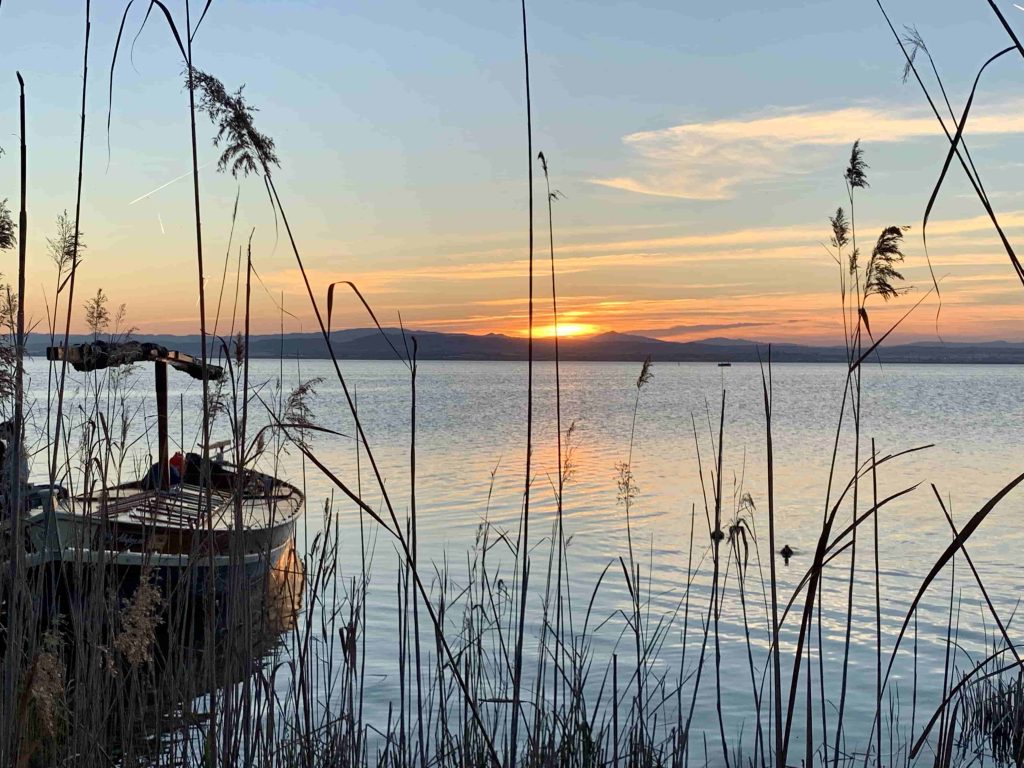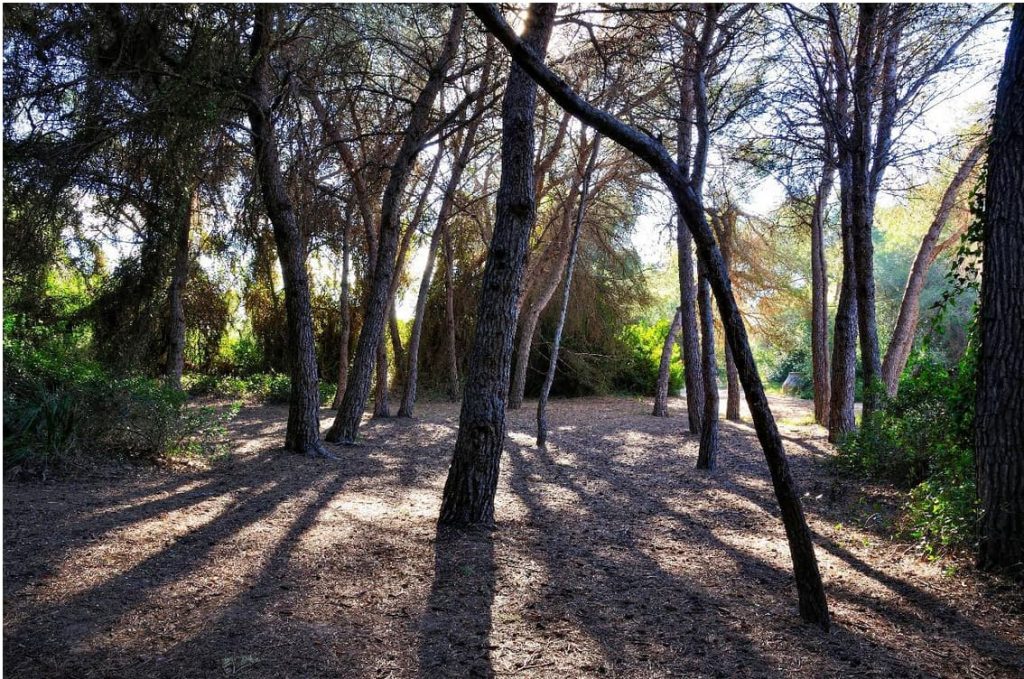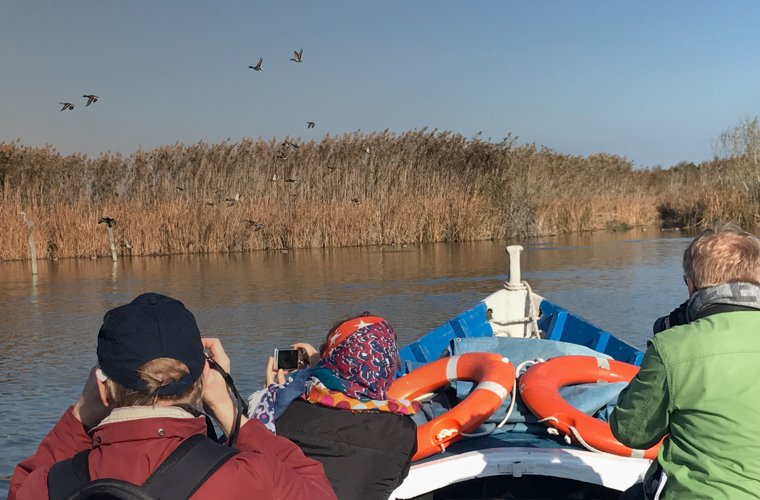The Lagoon
According to its Arabic origin, “al-buhayra” (now Albufera) means the little sea. In some Arabic poems it is referred to as the Mirror of the Sun and the Romans even it was knonw as Nacarum Stagnum, which means “lake of mother-of-pearl”. These terms already give an idea of the beauty and romanticism that characterizes this place, which the Valencian writer Vicente Blasco Ibáñez placed in his famous novel “Cañas y barro”.
Albufera de Valencia is one of the most representative and valuable coastal wetlands in the Valencian Community, to the point that in 1986 it was declared a Natural Park. It is the largest freshwater lagoon in Spain, with an area of 3000 hectares with an average depth of only 1.20 hectares. The water supply to the lake comes from the Júcar River and, to a lesser extent, from the Turia River. The Albufera is connected to the Mediterranean Sea through three water evacuation channels called “Golas” where the floodgates are located and allow the water of the lagoon to be managed depending on the demand of the rice fields.
Its value for the environment is extremely important because they live in it endangered species, such as “fartet” and “samaruc”, endemic species of Albufera Lagoon.
Fish species such as “fartet”, tusks, “samaruc”, eel, mullet or sea bass stand out in the fauna of the Albufera, as well as a diverse birdlife in which the mallard, herons, gulls, terns, European Ibis and increasingly flamingos predominate by population.
Among the flora, the reed, the cattail, and the “masiega” (cladium mariscus) stand out, mostly concentrated in the so-called “matas”, six islets distributed throughout the lagoon that are home to dense vegetation and serve as a refuge for birds and a place to nest. These islets are called “Mateta de Baix”, “Mata de la Barra”, “Mata de l’Antina”, “Mata de San Roc”, “Mata del Rey” and the most important “La Mata del Fang” which today is the natural bird reserve of the Albufera Lagoon, thus housing a great biodiversity of the ecosystem.


“La Devesa” forest
“La Devesa” has an extension of 10 kilometers (of the 35 km of the coastal ridge) and an approximate width of 1 kilometer.
Among the flora of “Devesa” are the Aleppo pine and the sea juniper, and an undergrowth in which mastic, buckthorn, kermes oak, sarsaparilla, butcher’s broom, palm hearts and asparagus grow.
The fauna of the Devesa is also very varied, from rabbits, red-legged partridges to wild boars and genets. There is also a diverse group of birds that reside throughout the year and many others that use the Dehesa natural park as a resting place in their migrations. As it is a place very rich in flora and vegetation, the insects that live there are also numerous.
Getting to know it is as essential as the lagoon itself and for this we make guided excursions through itineraries and conditioned routes: the historical route of the Gola del Pujol, the botanical path or the suggestive itinerary of the senses, among others.
The Marsh
The rice fields of La Albufera Natural Park are a traditional agricultural system which consists of rice cultivation in a marshy area that surrounds the lake of La Albufera.
Rice paddies are an essential part of the landscape of La Albufera and play an important role in the conservation of this ecosystem. Rice cultivation in this area dates back centuries and has become a traditional activity that is part of the culture and history of the region.
The landscape of the rice fields is characterized by the presence of extensive plots flooded with water, where rice is grown. These plots are divided into squares, called “tancats”, separated by dirt roads, which allow access to farmers. The water used to irrigate the rice fields comes mainly from the Júcar River, to a lesser extent from the Turia River, but also from the Albufera lagoon itself,
which has a similar function to a reservoir for rice irrigation The rice cultivation cycle in La Albufera begins in the spring, when the land is prepared for planting and the water is distributed in the rice fields. In summer, the rice plants grow quickly and the field takes on a deep green color. In autumn, the harvest is carried out, and then the rice fields are flooded with water in the so-called “Perelloná” and serve as habitat for migratory birds that visit the Natural Park during the winter.
In addition to their cultural importance, the rice fields of La Albufera also play a fundamental ecological role. They act as a natural filtration zone, helping to purify the water which reaches the Albufera and serving as habitat for numerous species of waterfowl, fish and other animals.
In short, the rice fields of La Albufera Natural Park are an indispensable element of this unique ecosystem Their picturesque landscape, cultural significance, and ecological role make them one of the most prominent attractions in the area.


+350 Birds
Valencia’s Albufera is a place of great natural beauty that is home to a diverse and rich birdlife. More than 350 species of birds have been recorded, both resident and migratory.
The main value of this area lies in the populations of waterfowl present throughout the year, with figures especially outstanding during the breeding and wintering period. During migratory passages, La Albufera also offers a suitable habitat for many birds.
Among the birds that can be observed in the lagoon area are various aquatic species, such as herons, flamingos, mallards, coots and grebes.
In addition, it is an important refuge for birds of prey such as the booted eagle, marsh harrier and common kestrel.
In the Albufera you can also find species of forest and field birds, such as the common nightingale, goldfinches, the European bee-eater and the common lark. These birds breed in the forests and vegetation areas near the lagoon.
Other interesting bird species that can be observed include the Common Tern, the Avocet, the Black-footed Plover or the Stilt.
In short, Valencia’s Albufera is a paradise for bird lovers, with a wide variety of species inhabiting its waters and surroundings. It is a place that offers the opportunity to observe and enjoy the beauty of the birdlife in an exceptional natural environment.

